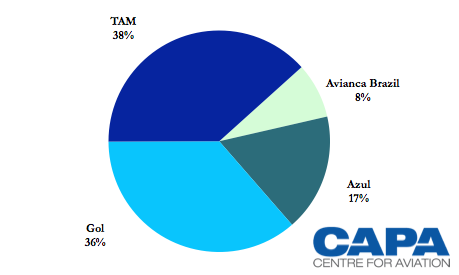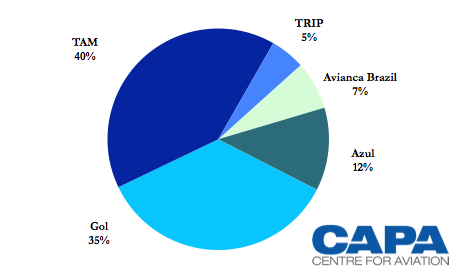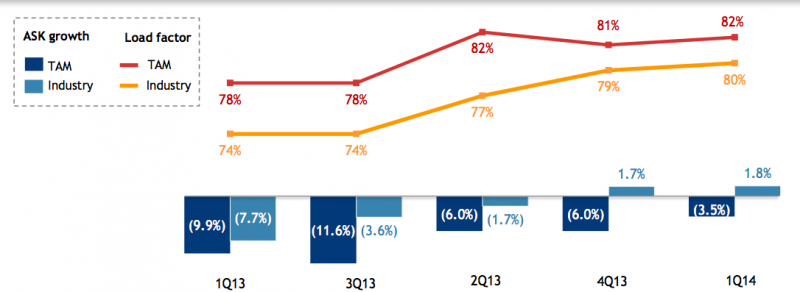Brazil’s domestic traffic shows encouraging growth in early 2014 as capacity remains rational
Traffic in Brazil's domestic market rebounded during the first four months of 2014 as overall capacity growth in the country remained disciplined largely due to continuing restraint from Brazil's two largest airlines TAM and Gol.
Avianca Brazil and Azul continued to grow capacity, as measured by ASKs from Jan-2014 to Apr-2014, as both airlines work to solidify their respective stances in the Brazilian market. But the expansion by those carriers should not result in a state of oversupply.
Despite the hype of the FIFA World Cup tournament held in Brazil beginning in mid-Jun-2014, the country's two largest carriers do not expect any financial benefit from the event, and are bracing for a decrease in traffic and revenues.
- Traffic in Brazil's domestic market rebounded in the first four months of 2014 due to disciplined capacity growth from major airlines TAM and Gol.
- Avianca Brazil and Azul continued to expand their capacity, but this is not expected to result in oversupply.
- Despite the FIFA World Cup, TAM and Gol do not expect any financial benefit and are preparing for a decrease in traffic and revenues.
- TAM and Gol have seen improvements in load factors and unit revenues due to their capacity restraint strategies.
- Gol's international market share has grown, while TAM's has slipped due to capacity reductions.
- Both Gol and LATAM have low expectations for the World Cup, but anticipate a potential uptick in traffic after the tournament.
Gol and TAM keep capacity in check; Avianca Brazil and Azul continue their ASK surge
Brazil's domestic RPKs by 8.7% year-on-year in the first four months of 2013 while ASKs increased just 1%, based on data from ANAC. Avianca Brazil recorded the largest ASK growth, 20%, but on a small base as it remains by far the smallest of Brazil's four main domestic players with a 7% share of ASKs.
Azul as a group recorded 6% growth when factoring in ASKs from both Azul and TRIP. Azul acquired TRIP in 2012 and the airlines recently completed their integration. As a result ANAC is no longer listing TRIP data separately (as it still did in 2013).
Brazilian ASK growth year-on-year by carrier: Jan-2014 to Apr-2014 vs Jan-2013 to Apr-2013
| Carrier | ASK increase/decrease |
| Avianca Brazil | 20% |
| Azul* | 6% |
| Gol | flat |
| TAM | 3% decrease |
Brazil market share (based on RPKs) by carrier: Jan-2014 to Apr-2014 vs Jan-2013 to Apr-2013
|
4M2014
|
4M2013
|
Both TAM and Gol continued their capacity restraint in Brazil's domestic market during the period spanning Jan-2014 to Apr-2014. TAM's capacity declined 3.4% year-on-year and Gol's ASK growth was flat, reflecting both carrier's strategies to better match supply with demand to gain pricing traction.
As a result of their tempered capacity both carriers were able to significantly improve their domestic load factors. Gol recorded an 8.8ppt improvement in load factor to 76.8% and TAM recorded a 4.8ppt improvement to 81.2%. The higher load factor drove up Gol's market share, based on RPKs, by 1ppt to 36% while TAM's market share still fell 2ppt year-on-year to 38%.
Avianca Brazil also increased its market share (based on RPKs) by 1ppt year-on-year to 8%. Avianca Brazil retained its position as the carrier with the highest load factor, which reached 84.5% in the first four months of 2014. Azul's load factor was 79.9%.
Capacity growth by Avianca Brazil and Azul should not disrupt the overall supply-demand balance in CY2014 as Gol plans to decrease its domestic supply 1% to 3% for the year while TAM plans flat domestic capacity. The rate of growth at Avianca Brazil and Azul also has been slowing down in recent months.
See related reports:
- LATAM Airlines Group's merger pains are aggravated by currency woes across multiple markets
- Gol presses forward with international expansion as it records losses in 1Q2014
Gol and TAM are seeing some benefits from their domestic ASK rationalisation
The traffic growth recorded by Brazilian carriers for the four months ending in Apr-2014 was a turnaround from the nearly 2% decline recorded a year earlier as ASKs in the domestic market fell 7%. During the first four months of 2013 TAM's ASKs fell nearly 10% year-on-year as Gol recorded flat growth. Gol began its domestic overhaul to shore-up its performance before TAM, which is reflected in Gol's 9% ASK decline in CY2012 versus a 4% decrease for TAM.
Both TAM and Gol have seen somewhat of a rebound. TAM's 82% load factor for 1Q2014 was better than the industry average of 80%. Its unit revenues in Brazil declined just 1% in the quarter, and the airline estimated its corporate revenues in the Brazilian domestic market increased 20% year-on-year.
TAM's ASK growth and load factor in Brazil: 1Q2013 to 1Q2014
Gol's yields grew 4% year-on-year during 1Q2014, an encouraging improvement given that domestic traffic represented roughly 92% of Gol's overall traffic during 1Q2014.
Gol increases international market share as TAM's slips due to capacity pull-downs
For the first four months of 2014 Gol's share of the international market grew from 12% to nearly 15% year-on-year (based on RPKs flown by Brazilian carriers). Gol has a stated goal of garnering 17% of its revenues from international flights by 2016, using 2013 as a baseline when 8% of revenues were derived from international services.
Gol launched service from Sao Paulo Guarulhos and Rio de Janeiro to Miami and Orlando in late 2012. Beginning in Jul-2014 the airline plans to launch flights from Campinas Viracopos to Miami via Santo Domingo. Campinas is the largest base for Azul, which recently unveiled plans to launch service to the US in 2015 with Airbus A330s. The airline has also ordered five A350-900s.
Following the revelation of its ambitions to serve the US, Azul filed an application with the US Department of Transportation (DoT) to operate service from Campinas to Fort Lauderdale and Orlando beginning in Dec-2014 and Campinas to JFK from Jul-2015. As previously reported by CAPA, Azul's entry into the US-Brazil market could be especially challenging for Gol since its one-stop service could be viewed as inferior to Azul's low-fare, nonstop service. So it is far from certain if Gol can achieve its targeted international revenue growth.
See related report: Azul shakes up Brazil market with A330s and US routes, becoming first long-haul LCC from the Americas
TAM's international market share (based on RPKs carried by Brazilian carriers only) slipped from 88% to 85% during the first four months of 2014 as its ASKs on international routes fell by 9% year-on-year and RPKs decreased by 2%. Previously TAM parent LATAM has guided that its capacity in international markets (long-haul and regional) should be flat to down 2% in CY2014. As part of the LAN-TAM integration, LATAM opted to cut TAM's flights from Rio de Janeiro to Europe and consolidate long-haul operations in Brazil at Sao Paulo Guarulhos.
Gol and LATAM have low expectations for World Cup
Neither Gol nor LATAM is overly excited about any commercial benefit from Brazil's hosting of the World Cup. Gol has said its outlook for the tournament (12-Jun-2013 to 13-Jul-2014) is uncertain, but the airline expects general softness in corporate demand.
LATAM also believes that corporate demand will soften significantly during the tournament, and that Brazilian residents who would normally take vacations in that timeframe will opt to remain at home. As CAPA reported on 7-Jun-2014, LATAM expects a significant drop in passenger traffic and revenues during the World Cup. TAM has cut domestic capacity during the World Cup as the additional flights between host cities on peak days does not come close to offsetting the reduction in frequencies across most of TAM's network in response to the reduced demand.
See related report: LAN Airlines cuts Chile domestic capacity, as World Cup traffic slump adds another hurdle for LATAM
But the World Cup should prove to be just a short-term blip and there could be an uptick in traffic after the tournament as some Brazilians may opt to delay their (southern hemisphere) winter holidays until late July or August. Brazil's rebound in domestic traffic during the first four months of 2014 is encouraging, and the capacity growth shows an overall rational supply-demand balance that should stay in place for the remainder of 2014.
However, with just 1.8% forecasted GDP growth for 2014, continuing currency depreciation and the fall-off in demand during the World Cup, achieving and sustaining pricing traction could prove difficult for Brazilian airlines. Given the uncertainty created by currency fluctuations and Brazil's tenuous economy, it would seem logical for all Brazilian airlines to temper their growth projections.


